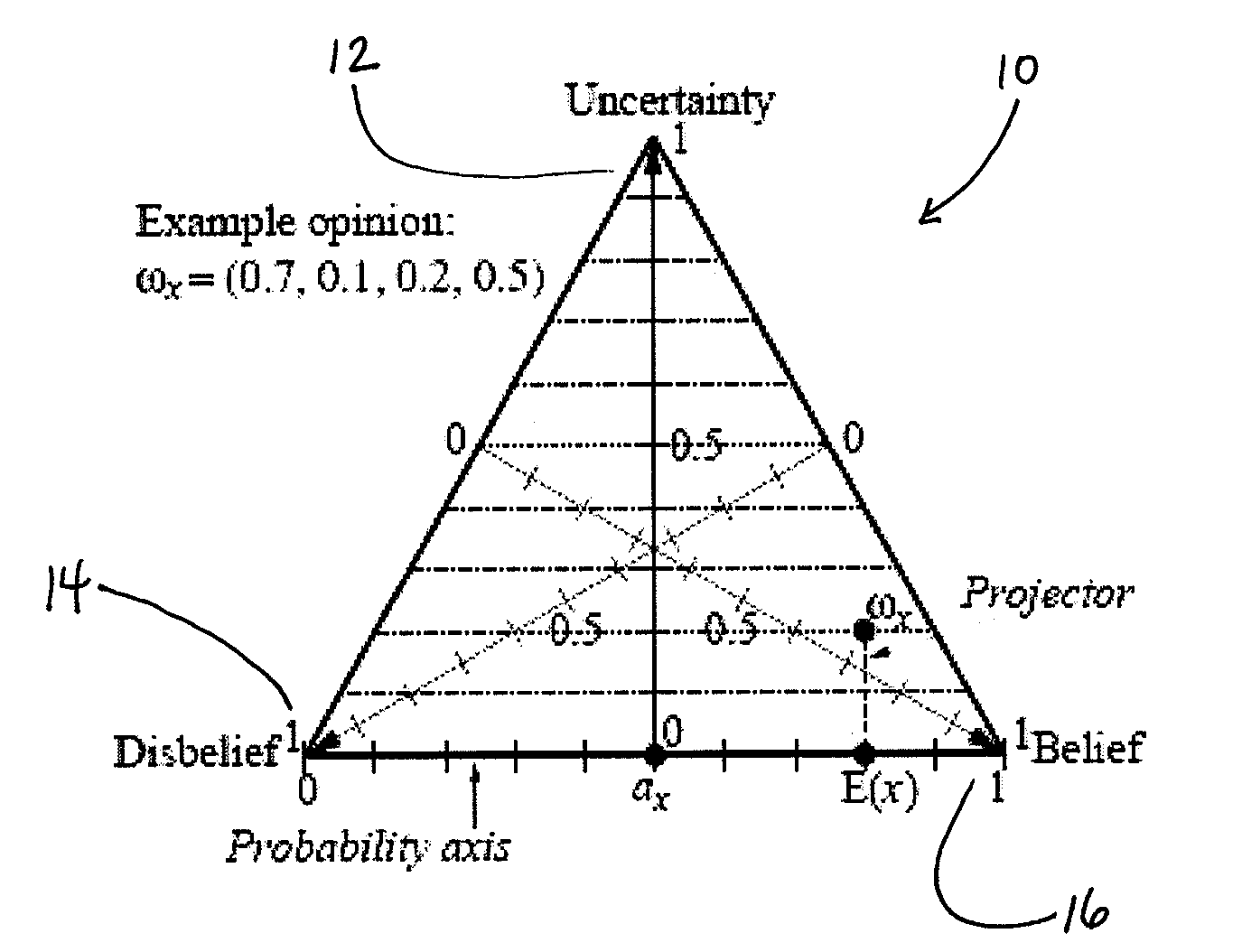Intelligence analysis method and system
a technology of intelligence analysis and intelligence, applied in the field of intelligence analysis methods and systems, can solve problems such as redundancy in separate analysis of diagnosticity of eviden
- Summary
- Abstract
- Description
- Claims
- Application Information
AI Technical Summary
Benefits of technology
Problems solved by technology
Method used
Image
Examples
example
[0229]The following example illustrates construction of a simple model using the method and employing the ShEBA software application. The software application is implemented in the Eclipse modelling framework and is hosted on the computer-based system depicted in FIG. 12. The system of FIG. 12 includes a user machine which provides local processing and storage facilities. The user machine includes an XML store in local file system storage and a client modelling framework software module. The user machine, which may be one of several user machines, is coupled to a knowledge base server which provides access to an object store in the form of a database. The database server facilitates the retrieval and storage of models, sources, evidence, results and associated annotations. In turn, the knowledge base server is coupled to a network server which executes monitoring and alerting agent software module for interfacing with external systems and / or data sources, such as messaging, logging ...
example 1
1) Example 1
[0297]Consider an exhaustive set of hypotheses H={h1, h2, h3}, and the respective expectations of their conditionals with respect to a item of evidence, e to be:
E(ωh1|e1)=1.0 E(ωh1|ē)=0.0
E(ωh2|e2)=0.0 E(ωh2|ē)=0.35
E(ωh3|e3)=0.0 E(ωh3|ē)=0.65
Since both the sums of the positive conditionals and the sums of the negative conditionals of H add up to 1, i.e.:
[0298]∑n=1n=3E(ωhne)=1,∑n=1n=3E(ωhne_)=1
and therefore the mean of the difference between the positive and negative conditionals is zero, and the sum of all conditionals is exactly 2, i.e.
Dmean(e, H)=0, Etotal(e, H)=2
it follows that the simplified form (A-14) can be used to obtain:
D(e,H)=1.0-0+0-0.35+0-0.652=1.0
The diagnosticity of the evidence e in respect of all hypotheses is D(e, H)=1.0—since when the evidence is true, h1 must be true and all other hypotheses (h2, h3) must be false. Furthermore, the diagnosticities with respect to the subsets of H (using A-13) are:
D(e, {h1, h2})=1.0
D(e, {h2, h3})=0.3
D(e, {h1, h3})=1.0
so ...
example 2
2) Example 2
[0299]Consider another exhaustive set of hypotheses H={h1, h2, h3, h4}, and the respective expectations of their conditionals with respect to a item of evidence, x to be:
E(ωh1|e)=0.5 E(ωh1|ē)=0.1
E(ωh2|e)=0.2 E(ωh2|ē)=0.0
E(ωt3|e)=0.15 E(ωh3|ē)=0.5
E(ωh4|e)=0.15 E(ωh1|ē)=0.4
The diagnosticity of the evidence e with respect to a subset of the hypotheses H′⊂H, H′={h1, h12, h3} will be D(e, H′) and since both the sums of the positive conditionals and the sums of the negative conditionals of H′ do not add up to 1, i.e.
[0300]∑n=1n=3E(ωhne)=0.85,∑n=1n=3E(ωhne_)=0.6andthereforeDmean(e,H′)=0.25,Etotal(e,H′)=1.45
it follows that the more usual form (A-13) must be used to obtain D(e, H′):
D(e,H′)=(0.5-0.1-0.083+0.2-0.0-0.083+0.15-0.5-0.0831.45=0.6
with the diagnosticities with respect to the subsets of J′ being:
D(e, {h1, h2})=0.25
D(e, {h2, h3)})=0.65
D(e, {h1, h3})=0.3
E. Relevance
[0301]Relevance is a measure of how relevant the evidence is for determining the likelihood to a hypothesis, b...
PUM
 Login to View More
Login to View More Abstract
Description
Claims
Application Information
 Login to View More
Login to View More - R&D
- Intellectual Property
- Life Sciences
- Materials
- Tech Scout
- Unparalleled Data Quality
- Higher Quality Content
- 60% Fewer Hallucinations
Browse by: Latest US Patents, China's latest patents, Technical Efficacy Thesaurus, Application Domain, Technology Topic, Popular Technical Reports.
© 2025 PatSnap. All rights reserved.Legal|Privacy policy|Modern Slavery Act Transparency Statement|Sitemap|About US| Contact US: help@patsnap.com



